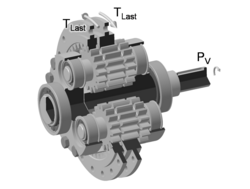Research Topic
| Short Title | Internal Gearing - Friction and Heat |
| Start of Project | Q1/2020 |
| Funding | FVA-Nr. 584/II, IGF-Nr. 20828 N Research Association for Drive Technology e.V., FVA Federal Ministry for Economic Affairs and Climate Action, BMWK |
| Contact | Dr.-Ing. T. Lohner |
Project Description
For reliable predictions of the energy dissipation and operating temperature of gearboxes, coupled calculation models for the power loss and heat flow are necessary. The aim of the research project is to develop a validated calculation approach for the coefficient of friction of internal gears. In addition, a validated thermal network for planetary gears will be developed for the computational determination of component temperatures. From the calculation results, reliable and validated statements on energy efficiency and impermissibly high temperature peaks can be made for planetary gear units, already in the design phase.
The state of knowledge regarding energy dissipation and heat flows in internal gears is expanded by combinatorial investigations of experimental and theoretical approaches. The tribological system understanding of the difference between internal and external gearing is improved by considering local influencing variables on the coefficient of friction along the path of contact using partial analytical approaches and numerical TEHL modelling. Based on these local considerations and the experimental investigations on the test gearbox of the FZG internal gear test rig (cf. Fig. 1), existing calculation approaches for the mean coefficient of friction are examined and a validated approach for internal gears is developed. For the computational determination of component temperatures, necessary thermal conductance values for gear components are derived from measured component temperatures and a validated thermal network for planetary gears is established.
By using reliable calculation models, reliable statements on the power loss behavior and operating temperatures of internal and planetary gears can be made. The formulas provided and their integration into proprietary or commercial calculation programs result in immediate benefits through the possibility of designing more energy-efficient and reliable planetary gear units.
